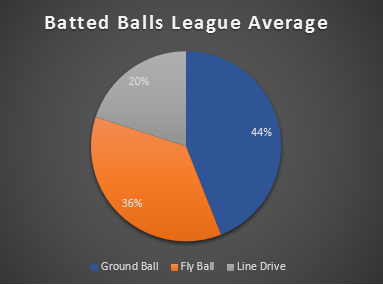Advanced Batting Stats
As I mentioned in the lesson on advanced pitcher stats, the reason we can trust advanced stats in baseball is because the sport is so binary; the basic batter-pitcher relationship never changes, so we see the same standardized events happen on a consistent basis.
With hitters, we can use different stats to accomplish different goals. Maybe you’re in a cash game and want to find the best overall value. You could use a different advanced stat than if you were in a tournament and wanted to identify the top home run threats in a given day.
In this lesson, I’m going to take a look at five important advanced batting stats. You can find more information and actual data in the Advanced Stats section of the Daily Research area. As with any stat, the goal is to allow for more accurate predictions.
Weighted On-Base Average (wOBA)
wOBA is a great catch-all stat that attempts to capture offensive value by weighting hits according to how many runs they actually create. That’s something that batting average, on-base percentage, and slugging percentage don’t do.
wOBA will give you a more accurate sense of a player’s overall value, which should translate to daily fantasy baseball. It’s best use is in cash games when you’re trying to find pure value.
Batting Average on Balls In Play (BABIP)
BABIP is a stat we talk about a lot because it captures an aspect of hitting that typically regresses toward the mean. Over the long run, most hitters will get on base on around 30 percent (or just below) of the balls they put into play. That’s why it’s so important to simply get the ball into play and not strike out.
There are some players who can continually get on base at a higher rate—namely speedy players who can turn groundballs that don’t make it out of the infield into hits. For most players, though, you can use BABIP to determine how much of their past success was due to luck; a low BABIP can actually be good because it suggests that the hitter should have gotten on base more than he did in the past based on how often he put the ball into play (and should thus improve his average in the future).
Isolated Power (ISO)
ISO is a metric that attempts to quantify a hitter’s raw power. It’s simple to calculate: slugging percentage minus batting average. ISO measures how often a batter can be expected to hit for extra bases.
ISO is most useful in GPPs when you’re seeking upside. It’s a decent proxy for home runs—more accurate than using past home runs. You can find wOBA, BABIP, and ISO in the Advanced Stats section of the Daily Research area.
On-Base Plus Slugging Plus (OPS+)
OPS+ is a version of OPS, which simply adds a player’s on-base percentage and slugging percentage. OPS is a very popular advanced stat in the daily fantasy community because it accounts for basically all aspects of hitting.
OPS+ incorporates extra variables into the equation, the most important of which is park factors. Adding park factors into the calculation helps to show which hitters are truly the best (as opposed to which ones are benefiting from a hitter-friendly home ballpark).
Batted Ball Stats
Batted ball stats simply show what percentage of a hitter’s batted balls were groundballs, flyballs, and line drives. When you look at how many runs are created from each type of batted ball, you see that there’s a major difference between them, with line drives obviously being optimal, followed by flyballs and then groundballs.
Here’s a look at the league average batted ball rates.

You can use batted ball profiles to see how well a particular hitter is really swinging. If you have a hunch that a recent hot streak was primarily due to luck, for example, you could look at his batted ball profile to see how he’s hitting the ball. If you see a high rate of ground balls—way over the 44 percent league average—that suggests he’s been lucky in having a lot of groundballs sneak through the infield.
No matter what advanced stats you examine, it’s important to remember that they can’t be used as standalone tools. Certain stats can help you make more accurate predictions in specific situations; there’s no “best” stat, especially in a sport like baseball in which basically everything that happens is tracked.
Further, you should use stats in conjunction with others. If you see that a hitter has a high rate of line drives and fly balls, for example, you might also check his ISO to get a sense of his true power. When you have multiple stats working in accordance with one another, that’s the best sign that the effect you think you see is real.
